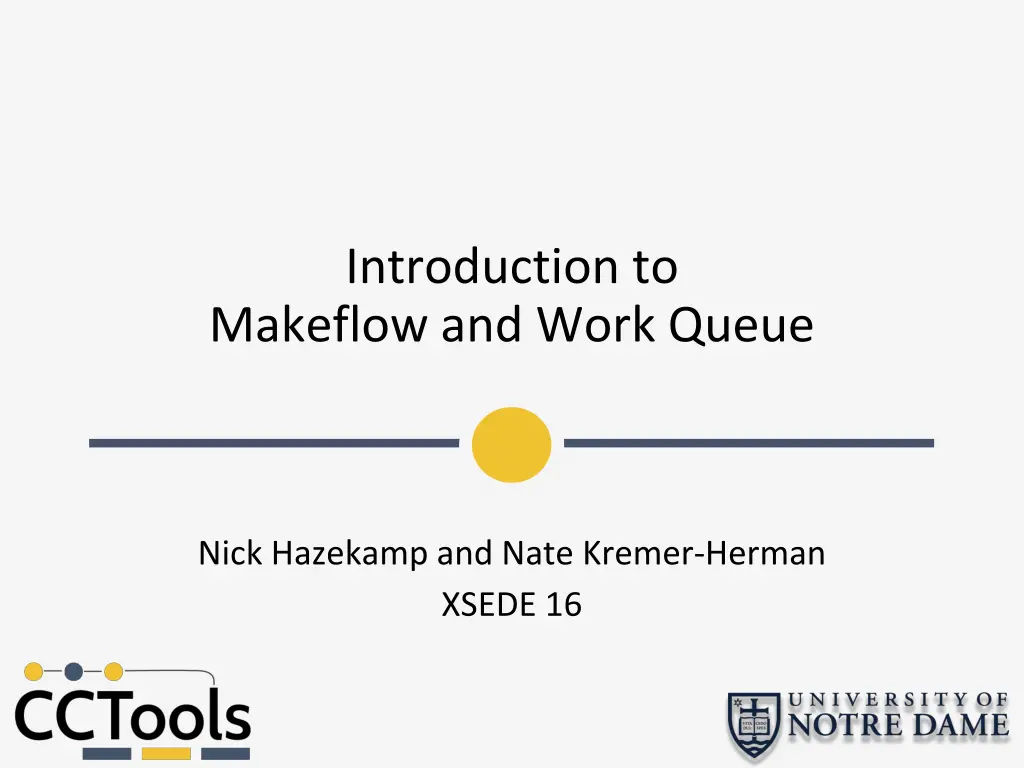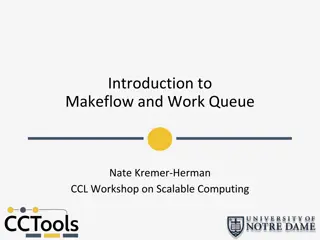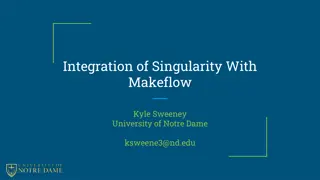
Introduction to Makeflow and Work Queue
Learn about Makeflow and Work Queue, tools developed by the Cooperative Computing Lab to address large-scale computing problems in various fields. These tools provide portable workflow management, resource harnessing, and familiar interfaces for connecting applications across different systems. Explore the philosophy and components of CCTools as well as the syntax of Makeflow for efficient workflow management.
Download Presentation

Please find below an Image/Link to download the presentation.
The content on the website is provided AS IS for your information and personal use only. It may not be sold, licensed, or shared on other websites without obtaining consent from the author. If you encounter any issues during the download, it is possible that the publisher has removed the file from their server.
You are allowed to download the files provided on this website for personal or commercial use, subject to the condition that they are used lawfully. All files are the property of their respective owners.
The content on the website is provided AS IS for your information and personal use only. It may not be sold, licensed, or shared on other websites without obtaining consent from the author.
E N D
Presentation Transcript
Introduction to Makeflow and Work Queue Nick Hazekamp and Nate Kremer-Herman XSEDE 16
The Cooperative Computing Lab We collaborate with people who have large scale computing problems in science, engineering, and other fields. We operate computer systems on the O(10,000) cores: clusters, clouds, grids. We conduct computer science research in the context of real people and problems. We develop open source software for large scale distributed computing.
Our Philosophy: Harness all the resources that are available: desktops, clusters, clouds, and grids. Make it easy to scale up from one desktop to national scale infrastructure. Provide familiar interfaces that make it easy to connect existing apps together. Allow portability across operating systems, storage systems, middleware Make simple things easy, and complex things possible. No special privileges required.
A Quick Tour of the CCTools Open source, GNU General Public License. Compiles in 1-2 minutes, installs in $HOME. Runs on Linux, Solaris, MacOS, Cygwin, FreeBSD, Interoperates with many distributed computing systems. Condor, SGE, SLURM, TORQUE, Globus, iRODS, Hadoop Components: Makeflow A portable workflow manager. Work Queue A lightweight distributed execution system. All-Pairs / Wavefront / SAND Specialized execution engines. Parrot A personal user-level virtual file system. Chirp A user-level distributed filesystem.
Makeflow: A Portable Workflow System
An Old Idea: Makefiles part1 part2 part3: input.data split.py ./split.py input.data out1: part1 mysim.exe ./mysim.exe part1 >out1 out2: part2 mysim.exe ./mysim.exe part2 >out2 out3: part3 mysim.exe ./mysim.exe part3 >out3 result: out1 out2 out3 join.py ./join.py out1 out2 out3 > result
Makeflow = Make + Workflow Provides portability across batch systems. Enable parallelism (but not too much!) Trickle out work to batch system. Fault tolerance at multiple scales. Data and resource management. Makeflow Work Queue Local SLURM TORQUE
Makeflow Syntax [output files] : [input files] [command to run] One rule calib.dat sim.exe out.txt in.dat sim.exe in.dat p 50 > out.txt out.txt : in.dat calib.dat sim.exe out.txt : in.dat sim.exe p 50 in.data > out.txt sim.exe p 50 in.data > out.txt Not quite right!
You must state all the files needed by the command.
example.makeflow out.10 : in.dat calib.dat sim.exe sim.exe p 10 in.data > out.10 out.20 : in.dat calib.dat sim.exe sim.exe p 20 in.data > out.20 out.30 : in.dat calib.dat sim.exe sim.exe p 30 in.data > out.30
Makeflow + Batch System Makefile XSEDE Torque Cluster Private Cluster Makeflow Campus Condor Pool Public Cloud Provider Local Files and Programs
Makeflow + Work Queue torque_submit_workers W W Makefile XSEDE Torque Cluster W Private Cluster W submit tasks W Thousands of Workers in a Personal Cloud W Makeflow W W W Campus Condor Pool Public Cloud Provider ssh W W W W Local Files and Programs condor_submit_workers
Advantages of Work Queue Harness multiple resources simultaneously. Hold on to cluster nodes to execute multiple tasks rapidly. (ms/task instead of min/task) Scale resources up and down as needed. Better management of data, with local caching for data intensive tasks. Matching of tasks to nodes with data.
Project Names makeflow N myproject work_queue_worker N myproject connect to workflow.iu:9050 Makeflow (port 9050) Worker advertise query work_queue_status Catalog query myproject is at workflow.iu:9050
Work Queue Visualization Dashboard ccl.cse.nd.edu/software/workqueue/status
Resilience and Fault Tolerance MF +WQ is fault tolerant in many different ways: If Makeflow crashes (or is killed) at any point, it will recover by reading the transaction log and continue where it left off. Makeflow keeps statistics on both network and task performance, so that excessively bad workers are avoided. If a worker crashes, the master will detect the failure and restart the task elsewhere. Workers can be added and removed at any time during the execution of the workflow. Multiple masters with the same project name can be added and removed while the workers remain. If the worker sits idle for too long (default 15m) it will exit, so it does not hold resources while idle.
Visit our website: ccl.cse.nd.edu Follow us on Twitter: @profthain Check out our blog: cclnd.blogspot.com


